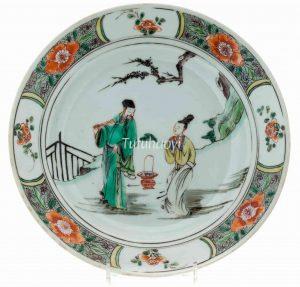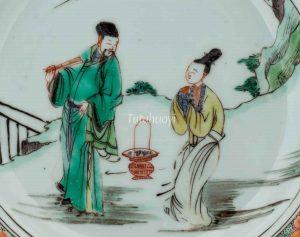Qiuhu trying to seduce his own wife
秋胡戏妻 (鲁洁妇)
© Tutuhaoyi.com owns the copyright of the description content for the images attached. Quoting all or part of the description content on this page is permitted ONLY IF ‘Tutuhaoyi.com’ is clearly acknowledged anywhere your quote is produced unless stated otherwise. (本页描述内容版权归Tutuhaoyi.com所有,转发或引用需注明 “Tutuhaoyi.com”, 侵权必究, 已注开源信息的条目除外。)
Qiuhu (秋胡), a native of the state of Lu during the Spring and Autumn period (770-476 BCE), was ordered to take up an official post in the state of Chen a scant five days after his marriage to Jiefu (洁妇), the ‘Loyal Wife’. Five years later, on his way back home, he encountered a woman by the roadside picking mulberry leaves, used as food for silkworms.
Qiuhu approached the woman and told her that toiling among mulberry leaves was certainly not as fun as yielding to a high-ranking minister’s offer who took a fancy to her. Qiuhu baited the woman with some gold ingots. The woman retorted, ‘I work hard to support my parents-in-law and the son left behind by my husband. I wish that you did not take fancy of women outside your family. I have no intention of fooling around. Take your gold back.’
On arriving home, Qiuhu sent for his wife and, to his great embarrassment, discovered that she was none other than the woman he had solicited.
There are two endings to this story. One version relates that after condemning Qiuhu for being lecherous and for not exercising virtues of filial piety to his parents, as was customary, the wife felt so disheartened that she threw herself into the river. The other ending, suggested by the Yuan dynasty literatus Zhao Mengfu (赵孟頫, 1254–1322), is a happy one. In his version, Qiuhu was merely testing his wife. Since she proved to be chaste and not materialistic, he reunited with her and they lived happily ever after.
Reference:
Jeffrey P. Stamen and Cynthia Volk with Yibin Ni (2017), A Culture Revealed: Kangxi-Era Chinese Porcelain from the Jie Rui Tang Collection 文采卓然:潔蕊堂藏康熙盛世瓷, Jieruitang Publishing, Bruges, pp. 28-29.
Fig 1-2: famille verte dish, Kangxi period (1662-1722), courtesy of The Stamen Collection
Fig 3: blue-and-white porcelain jar, Zhengtong – Tianshun period (1436-1464), Ming dynasty, courtesy of Tianjin Museum
Fig 4: hexagonal bowl, Kangxi period (1662-1722), courtesy of Rijksmuseum, Holland



